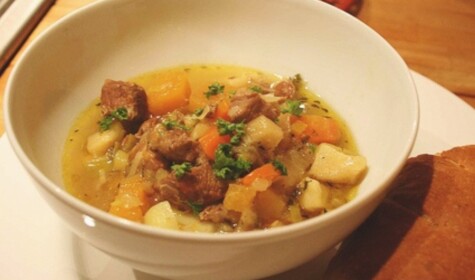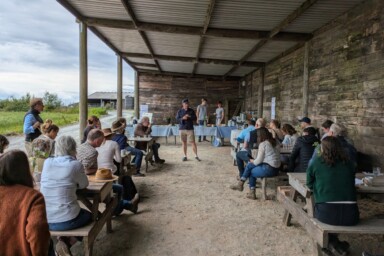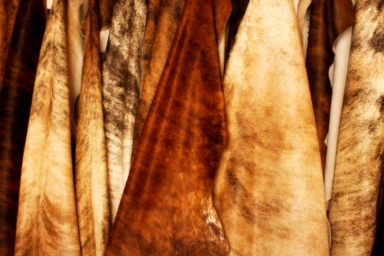The Welsh stew ‘Cawl’ is probably the strongest survivor of the country’s traditions of ‘peasant’ cooking. Warming, hearty and affordable, it has a resonance around home and family that gives me a sense of all being well with the world. A winter staple for so many families when I was growing up, it remains emblematic in Wales’ culinary identity – but perhaps more importantly, highlights how living food traditions can play a key role in the transition to sustainable food.
The origins of cawl lie in the Middle Ages or earlier, with the Welsh word deriving from the Latin for cabbage; from there, the word came to be used for a stew in which any greenstuff was present. By the 15th century, the word was used by traditional physicians in Wales to denote a liquid that could be drunk, often translated into English as ‘pottage’. But even though the origins of cawl lie with cabbages, leeks have long been one of its principal ingredients, essential for imparting flavour with references to its importance locally turning up in 18th century ditties and poems. There is a detailed description of what went into a normal family’s cawl by the early 19th century, from the traveller Heath Malkin. On his tour of romantic Wales in 1804, he describes the diet of rural cottagers in Glamorgan:
“Broths made from all sorts of meat are much used; in which large quantities of potherbs and other vegetables form a principal ingredient; abundance of leeks, onions, shalots, parsley, savoury, pennyroyal, marjoram, thyme, cresses, beets, lettuces, spinage, and other productions of the garden. Herb broth, as it is called, is much used by the common people….and [they] take it with bread.”
Most people would agree that this classic recipe from southern Ceredigion lies near the middle of the range of possibilities in cawl. The recipe calls for a joint each of bacon and either mutton or beef, along with swede, carrots, cabbage, potatoes, leeks, parsley, oatmeal and water. You put the joints of meat together into a large saucepan and boil them for at least an hour. You would then add the root vegetables and boil them for 15 minutes or so, before the putting the potatoes in. Allow this to boil further so that the juices and flavours start merging, and finally add the leek and a small amount of parsley, ten minutes or so before serving.
In a similar twist to traditional variants of the Marseillaise bouillabaisse (fish stew), where the fish and the broth are served separately, the broth in a cawl of this sort was traditionally served clear, with the vegetables and meat dished up as a second course along with bread and cheese. The best cawl, like well-matured wine or cheese, is best served reheated and eaten the day after it is first made (called ‘cawl eildwym’), so that all the flavours have time to seep into each other and become a masterpiece of peasant cookery.
But the real thing about cawl that is important for me, is how widespread the dish continues to be. It can now be found widely on restaurant and gastropub menus across Wales (though this is a phenomenon that only started within the last few decades, when the pioneering Bobby Freeman first introduced it at her Fishguard restaurant – the good, staunchly Welsh rural folk of North Pembs were horrified at the thought of their lowly home dish served in a restaurant). In essence though, cawl remains very much a home-cooked dish. A few years ago, some friends of mine in their late twenties decided to have nothing but cawl for dinner for six months in order to save for a deposit on a house. That calculation wasn’t based on romantic affection for a ‘national dish’; it was made purely on the basis of the convenience and affordability of a tasty dish in the long, dark wet of Welsh winters.
And therein lies the rub: swedes, potatoes, carrots, leeks and the like will continue to be primary options for affordable, seasonal veg in the coming decades, regardless of the exact climate path we follow. On top of that, any long-term sustainable farming system in a place like Wales, needs to include livestock, with the fatty acids from pasture-fed animals going a long way in a dish like cawl. And the ability to batch cook a dish for a family needing only minimal cooking on the hob, that will last for several days and can then be reheated, is priceless – as I know with my own young kids. In fact, it seems to me that if we were designing a winter dish from scratch that used the most sustainable ingredients in this part of the world, ticking nutrition, flavour, ease and cost, we’d likely come up with something pretty similar to cawl.
But there is one respect in which Wales’ cawl heritage goes a step further. This comes out for me, often in conversation with older women in rural parts around where I live in Carmarthenshire, where the idea of ‘cawl’ as a recipe simply doesn’t chime with their own upbringing. For them, as with the subcontinental curry tradition, cawl is much more of an approach to seasonal cooking than it is a dish. ‘Cawl Awst’ (August cawl), ‘Cawl pys’ (Pea cawl) and many other variations that are now starting to fall out of memory, reflect a period that lasted until the 1960s in these parts, where seasonality was simply a fact of life, naturally reflected in all cooking. It was not the recipe, but the technique that mattered: use plenty of seasonal veg and herbs (even fruit), bring flavour from the seasonal meat, and ensure you make enough for leftovers the next day.
Of course, cawl is just one of so many dishes that fit this bill, even here in Wales; much the same could be said of ‘Ffest y Cybydd’, faggot dishes and even the pie tradition (which in these parts prominently included cockle, bacon and even limpet recipes). And though cooking skills are now being lost intergenerationally, even in rural Wales, exciting initiatives such as Cook24 in Carmarthenshire are harnessing local chefs’ expertise and enthusiasm to teach everyone from primary school children to community leaders to cook from scratch, with cawl being a key recipe. Or should that be approach?







